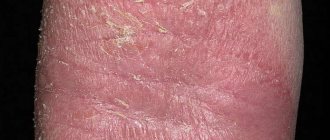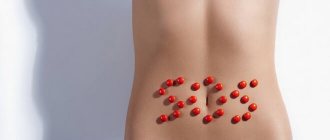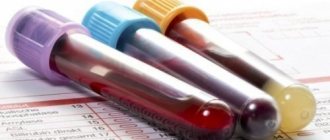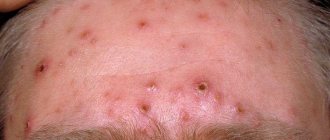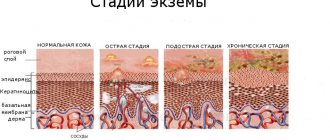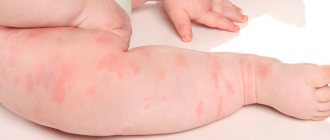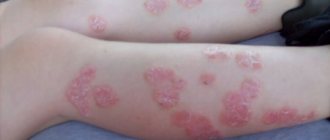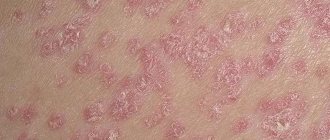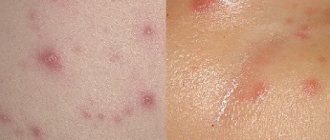Psoriasis on the elbows: treatment at home
The causes of the disease are still unknown to medicine, so treatment is aimed at eliminating the pathological symptoms. How to cure psoriasis on the elbows at home?
Therapy is carried out in three directions:
- use of external means;
- use of tablet drugs;
- folk remedies.
Advice! Folk remedies become an excellent addition to drug therapy, but do not replace it.
What rules should be followed during treatment?
Skin affected by psoriasis is cured only if certain rules are followed, which the patient must adhere to. A positive result is achieved only with a competent approach to the disease. It is necessary to take into account the severity of this disease by fulfilling the following treatment conditions:
- Follow instructions carefully and use prescribed medications regularly.
- If symptoms and signs appear to a minor extent, then use light remedies containing plant extracts, for example, aloe vera.
- If the manifestation of symptoms is associated with severe forms of psoriasis, then hormonal drugs are prescribed.
- The skin should be moisturized to its normal state through the use of special creams.
- If the crust does not fit too tightly after softening, it is removed.
- By removing the crusts, lotions and medicated creams are absorbed more efficiently.
- It is necessary to maintain the accuracy of the prescribed schedule for taking UV therapy and sunbathing procedures.
In general, conventional remedies can cure the symptoms of psoriasis. Taking several different drugs and ointments at the same time at home is not recommended, since this approach is characterized by the inability to find out which drug is most effective.
It is necessary to take breaks between courses of treatment, the duration of which can be 1 to 6 months.
It is important to avoid irritating factors during the treatment and prevention of psoriasis by avoiding them. For local treatment, ointments, gels and lotions are mainly used, which are applied directly to the site of infection and inflammation.
This is the initial step in the treatment of psoriasis in the “ladder of therapeutic measures.” If the use of local therapy does not allow obtaining a positive result, then phototherapeutic methods are used. Systemic therapy is prescribed if the effectiveness of these methods is low
Local treatment mainly uses ointments, gels and lotions, which are applied directly to the site of infection and inflammation. This is the initial step in the treatment of psoriasis in the “ladder of therapeutic measures.” If the use of local therapy does not allow obtaining a positive result, then phototherapeutic methods are used. Systemic therapy is prescribed if the effectiveness of these methods is low.
How to treat psoriasis on the elbows at home: preparations for external use
Psoriasis on elbows treatment at home
How can you treat psoriasis on the elbows? The products used during the treatment process help to soften the keratinized particles and make the scales easier to remove.
Most often, ointment is used for psoriasis on the elbows; the names of the drugs should be known to all sick people.
- Daivonex. The medicine contains artificial vitamin D and promotes healing of the affected area;
- Tsinocap. The active component of the product is zinc. The ointment has drying and healing properties.
Causes
Psoriasis belongs to little-studied diseases, the causes of which have not been precisely identified. However, during the research, it was possible to form the main risk groups in which such a disease may develop on their elbows:
- heredity - in half of the cases the disease is inherited; it can manifest itself both in the immediate family and across generations;
- exposure to chemicals - with cracks and microdamages, they can penetrate into the deeper layers of the skin, causing a reaction from the body’s immune system;
- disturbances in the functioning of the endocrine system and cell regeneration;
- lack of microelements in the body;
- injuries to the shoulders and arms, cuts, abrasions;
- nervous tension, stress;
- long-term use of medications and excess of relevant substances.
The peculiarity of psoriasis on the elbows is its non-infectious nature. The disease does not spread from contact with affected areas of the skin, and is also not transmitted through kissing or sexual intercourse.
Popular ointments for psoriasis on the elbows
- Salicylic;
- Ichthyol;
- Naftalan;
- Cygnoderm;
- Bensalitin.
Ointments for psoriasis on elbows
What else is used to treat psoriasis on the elbows? For short-term use - in order to quickly relieve severe symptoms - steroid drugs are prescribed. These are ointments such as Dermovate, Andvantan, Ftorokort (see photo).
It is allowed to treat an inflamed elbow twice a day. The duration of use in each case is determined individually. The rule applies to all ointments containing steroid components.
Note! Drugs containing steroids are prescribed in short courses. The drugs cause numerous side effects.
Diagnostics
The first symptoms of psoriasis on the elbows are often ignored by people. Small rashes of papules are often mistaken for acne, irritation or an allergic reaction. A doctor is usually consulted at a progressive stage of the disease, when the affected area appears and unbearable itching appears.
It is recommended to consult a dermatologist in the early stages of the disease to avoid complications and discomfort. To diagnose psoriasis on the elbows, a visual examination is usually sufficient - any specialist can determine it without additional tools.
procedures may also be used during diagnosis :
- a skin biopsy is taken for laboratory research of the disease;
- blood and urine tests are required to determine the effectiveness of the drugs used;
- X-ray examination is used if a complex form of the disease and joint damage is suspected.
To exclude the possibility of a fungal infection, a potassium hydroxide test is also used. Similar procedures can be used both during the first diagnosis and during monitoring of the patient’s condition.
Based on the information received, the doctor draws up or adjusts the course of treatment for elbow psoriasis.
How to treat psoriasis at home on the elbows: tablets
Pathology therapy requires an integrated approach. In addition to treating psoriatic plaques with ointments, the patient is prescribed medications that alleviate other symptoms of psoriasis.
- To eliminate swelling and itching of the inflamed area, antihistamines, for example, Claritin or Zodak, are prescribed.
- To calm the nerves, a person is prescribed sedatives.
- To eliminate pain, it is recommended to use medications that have anti-inflammatory properties - Ortofen, Naproxen and others.
Important! The choice of drug and dosage selection should be carried out by a specialist.
Treatment methods for elbow psoriasis
To improve the condition, as well as reduce the likelihood of psoriasis, you need to:
- Adjust your regimen and diet, and if signs of illness appear, consult a doctor.
- First of all, it is necessary to constantly strengthen the immune system, eat healthy foods rich in vitamins and minerals.
- Sleep has a huge impact, it should be full.
- In addition, you need to avoid stressful situations, relax, and then you can protect yourself from a terrible disease.
Psoriasis is a rather terrible and insidious disease that requires immediate and comprehensive treatment. In order to protect yourself, it is necessary to take preventive measures and consult a doctor in time. Timely treatment of psoriasis can lead to an improvement in the condition, as well as an increase in the duration of the remission period.
There is no reason to assume that psoriasis will go away on its own, but you should not self-medicate either, because there is a risk of aggravating the course of a chronic disease. Relieving the inflammatory process is the first step on the path to recovery, since for long-term remission you will have to follow some of the doctors’ recommendations. To avoid exacerbation of psoriasis, it is necessary to adhere to the following preventive measures:
- follow a proper diet;
- exclude the consumption of alcoholic beverages, alcohol, sweets, spicy foods;
- get enough sleep, and the duration of sleep should be at least 8 hours a day;
- avoid mechanical damage to the skin, injuries;
- monitor the internal state of the body;
- develop skills to cope with stress;
- support the functioning of the immune system, avoiding infectious diseases;
- minimize contact with household chemicals.
Many patients underestimate the need for prevention when treating psoriasis on the elbows and after recovery. In fact, it helps to stop the progression of the pathological process and prevent its development in the future. Because the disease is difficult to treat, people should do everything they can to prevent symptoms from recurring. To do this, you should adhere to the following preventive measures:
- It is necessary to avoid situations that can lead to stress and unnecessary worries. Emotional experiences have a negative impact on the immune system. Due to its weakening, the disease may make itself felt again;
- It is necessary to follow the correct diet. When creating a menu for every day, it is advisable to pay attention to natural products that are enriched with beneficial microelements. It is necessary to exclude any allergens from the diet;
- You should take care of proper rest. A person should sleep about 7-8 hours a day;
- It is advisable to completely stop smoking and drinking alcoholic beverages. Bad habits have a bad effect on the immune system;
- Avoid damaging the skin. The slightest damage can bring back the disease;
- It is required to regularly visit a doctor and undergo diagnostics, which will help to timely identify the development of the pathological process in the skin tissues.
Don't forget about regular body care. Dermatologists advise giving preference to hypoallergenic products that are gentle on the skin and moisturize it well.
- Age of onset of the disease. Mostly, elderly people consult a doctor with this form of the disease; in children and adolescents, damage to this area is rare;
- Only in 30% of cases is the symmetry of the lesion determined - plaques form on both the right and left elbow. In other cases, the inflammation covers only one elbow area;
- Psoriatic lesions in psoriasis, unlike eczema and dermatitis, are localized only on the outer, extensor side of the joint;
- The disease is characterized by seasonality - most often exacerbations occur in the cold months of the year, that is, when the skin is more dehydrated;
- The rash can be either dry or wet;
- The lesions spread predominantly towards the forearm;
- Over time, elbow psoriasis causes thickening of the skin in the affected area. The skin becomes dense, dry, and quickly cracks, which is accompanied by the appearance of blood, pain and itching.
Elbow psoriasis must be treated and this must be done under the supervision of a dermatologist. The lack of therapy leads to the fact that it is impossible to completely remove all changes in the affected area, and this causes internal discomfort and can cause depression.
How to treat psoriasis on the elbows: folk methods
How is psoriasis on the elbows treated?
Psoriasis on the elbows: how can you treat the pathology? What folk recipes are used?
You can prepare a “garlic” medicine for psoriasis on the elbows . The product will be effective at the initial stage.
- Grind three to four cloves of garlic into a paste.
- Pour hot water (one and a half glasses) and let it brew for about an hour and a half.
- Use water for compresses.
How to cure psoriasis on the elbows at home? Baths with a decoction of medicinal herbs have proven themselves well.
- Combine celandine, string, chamomile and sage (take a tablespoon of each herb).
- Pour boiling water, maintaining a ratio of 1:10.
- Let the mixture sit for half an hour.
- Immerse your affected elbows in it.
Symptoms and first signs
Psoriasis is a disorder of the skin due to the accumulation of dead and dry cells on its surface. The affected area is slightly raised above the skin, has a pink-red tint and is covered with flaky silvery scales. Elbows are one of the locations of inflammation. It is found on the head, limbs, torso, knees, and groin area. A person may only have a few spots on their elbows; and then, during the period of exacerbation, scabs spread over the entire surface of the body.
Let's look at how this skin disease begins and progresses:
- The initial stage is accompanied by small red spots. They rise slightly above the skin.
- Over time, the inflammation increases and connects with each other, forming lesions. On top they are covered with silvery scales.
- Intense itching is observed in the damaged areas. Scratching will become a serious problem, especially if psoriasis is diagnosed in a child.
- With mechanical impact, the sores are easily injured and begin to bleed.
- In advanced cases, in the absence of the necessary treatment, crusts form on almost the entire surface of the patient’s body.
Also on the topic: Psychosomatics of psoriasis - psychological factors of scaly lichen
To have an accurate idea of what the disease looks like, just look at the photo.
The disease manifests itself as scaly formations on the skin
If you notice the first signs of psoriasis, consult a doctor who will prescribe the most effective treatment.
Solidol for psoriasis
Solid oil for psoriasis on the elbows
Psoriasis on the elbow can be treated with grease or birch tar .
Application scheme:
- apply the selected product and keep it on the elbow for 8 minutes;
- gradually the exposure time to the substance increases. Ideally, it is brought to 40 minutes;
- then the composition is removed using water and tar soap.
The duration of the course is two weeks.
Stages and forms
A chronic inflammatory process on the elbows, which, under the influence of a number of reasons, either increases or decreases, progresses without proper treatment. The course of therapy should be prescribed by a dermatologist, but to determine the effectiveness of the method, the choice of medications, and procedures, the doctor needs to evaluate the course of the disease. Further tactics will depend on the clinical picture, and it is customary to distinguish the following stages of skin lesions on the elbows with psoriasis:
- Initial. The surface of the skin on the outside of the elbows becomes covered with a rash. Reddish round spots with a white film grow, become covered with scales, and after 2-3 weeks plaques form. With timely treatment, the signs of psoriasis may disappear for some time and then appear again, or the lesion may appear in another part of the body.
- Progressive. This stage of the disease can be characterized by the presence of psoriatic elements with many scales. The appearance of such signs indicates the beginning of an exacerbation of psoriasis, and this is easy to notice by the presence of a hyperemic rim (redness) along the edge of a flaky plaque.
- Stationary. It is characterized by a decrease in the inflammatory process, which indicates the effectiveness of the treatment used. The appearance of new plaques on the elbows stops, there is no red rim around the psoriatic elements, their diameter decreases, and the scales completely cover the inflamed area.
- Regressive. Indicates partial recovery, while peeling is almost imperceptible or disappears, and pigmented areas of skin appear in place of the plaques. A further set of measures will be aimed at prevention, preventing exacerbations of psoriasis.
Experts distinguish several stages of psoriasis on the elbows:
- Progressive. At this stage, a huge number of small nodules appear, which are very noticeable on the skin due to their bright shade. At the edges they are outlined by a rim;
- Stationary. The disease stops developing. Existing rashes remain unchanged, and new plaques do not appear. The rash takes on a brownish tint;
- Regressive. All psoriatic processes subside. For some time, the skin clears of the rash. The patient is diagnosed with remission.
The pathological process is divided not only into stages, but also into different forms. Psoriasis can be:
- Ordinary;
- Exudative;
- Pustular.
Separately, there is psoriatic erythroderma, which is one of the most severe conditions, as it affects the nails and joints.
Psoriatic erythroderma is a severe form of psoriasis that can lead to disability
Celandine herb for psoriasis on the elbows
Celandine herb for psoriasis on the elbows
The herb celandine helps well with psoriasis . The alkaloids it contains inhibit the development of exacerbations.
- Take the herb of celandine, string, St. John's wort, valerian and marshmallow root, a tablespoon each.
- Pour boiling water (500 ml) into two spoons of the mix.
- Leave for six to seven hours.
- Filter and drink ½ of a glass twice a day strictly 30 minutes before meals.
The infusion prepared according to this recipe can be used for compresses.
Lotions with chicory for psoriasis on the elbows
How to treat psoriasis? Lotions with chicory give good results . The effect appears on the fifth day from the start of use.
- Pour two tablespoons of powder into a glass of boiling water.
- Heat the mixture in a water bath for 15 minutes.
- Filter and let cool. Can be used.
It is important to remember that folk remedies should be used in combination, and not cancel the prescribed drug treatment.
Diet for psoriasis
Attention is paid to proper nutrition both in the active form of elbow psoriasis and to prevent relapses. Spicy, fatty, smoked, salty and sweet foods are excluded from the diet . Sweet carbonated, low-alcohol and alcoholic drinks are prohibited.
Recommended products for a therapeutic diet include cheese, cottage cheese, vegetables and fruits with the exception of red ones, herbs, seaweed, lean meats and fish, berries, and whole grain bread. It is recommended to have fasting days twice a week, eating only kefir, apples and other light foods.
Also, for psoriasis on the elbows, monitor the body’s water balance :
- drink two liters of clean water daily, adding a small amount of lemon juice is allowed;
- limit the consumption of green and black tea;
- to relieve the disease, herbal infusions based on chamomile and flax seeds are considered useful;
- The diet includes freshly squeezed juices based on carrots, apples, celery, parsley, and spinach.
It is preferable to steam, boil or bake any dishes. Avoid or severely limit fried foods. Salt and hot spices are not allowed.
Treatment of psoriasis
And how to treat psoriasis on the elbows? Since the trigger of the pathology is unknown, therapy will be aimed at eliminating unpleasant symptoms. Do not forget that even with full confidence in the diagnosis and knowledge of how to treat such elbow pathology, in the event of an exacerbation it is necessary to consult a doctor who will prescribe treatment appropriate to the patient’s condition.
Medicines
At the initial stage of the disease, external preparations are often used to soften tissues and eliminate scales. To get rid of psoriasis on the elbows, the following ointments are recommended:
- Daivonex: to improve skin nutrition, contains vitamin D;
- Zinocap: main component – active zinc;
- naphthalan ointment;
- salicylic ointment;
- ichthyol ointment;
- Bensalitin;
- Cygnoderm.
Steroid drugs (Andvantan, Dermovate, Fluorocort) are especially effective, which help to quickly get rid of the rash. To do this, you need to apply the ointment to the elbow area twice a day. But, despite the excellent effect, such medications for psoriasis on the elbows are prescribed in short courses, due to numerous side effects.
Internal therapy involves an integrated approach and includes the following medications:
- antihistamines (Zodak, Claretin, Fenistil) to eliminate itching and swelling;
- sedatives (valerian, motherwort, Persen, Novo-Passit);
- anti-inflammatory drugs (Ibuprofen, Naproxen, Ortofen).
Antihistamines are used to eliminate itching in psoriasis.
It is worth noting that elbow psoriasis is a secondary manifestation. So timely comprehensive treatment will help achieve long-term remission and forget about the problem for a long time.
ethnoscience
The use of folk remedies for the treatment of psoriasis on the elbows at home is possible only in combination with the main therapy. You should not expect an immediate effect from such remedies, since treating psoriasis requires a significant investment of time and enormous patience. Most often, for psoriasis, medicinal baths based on herbal infusions (chamomile, string, sage, celandine) are used. Any such infusion is kept for half an hour, after which it is diluted with water 1:1 and the elbows are lowered into it. The procedure is continued until the water cools.
In the treatment of psoriasis, you can use baths with chamomile infusion
A garlic compress is also often used: grind a few cloves of garlic and add a glass of boiling water to the mixture. The product is kept for 1.5 hours. Next, compresses with the infusion are applied to the elbows and changed after drying. Lotions with chicory are no less effective. To prepare the medicinal base, you need to pour 2 tbsp. l. chopped chicory 200 ml of hot water and boil in a water bath for about a quarter of an hour. Using such a solution, after 5 days you can notice the subsidence of the inflammatory process, and after 10 days - the almost complete disappearance of all spots.
How to distinguish psoriasis from fungus?
Soreness of the skin, excessive dryness, peeling cause anxiety and doubt: what exactly is this dermatological disease, how dangerous is it to health and can it be transmitted through close contact?
A fungus similar to psoriasis has common symptoms, but the ailments require specific therapy. Until today, the exact causes of psoriatic rashes have not been established, but one thing is known: psoriasis is not a fungus, it has nothing to do with fungal infections.
Have you been trying to get rid of PSORIASIS for many years?
Head of the Institute: “You will be amazed at how easy it is to get rid of psoriasis by taking it every day...
Read more "
- What is special about psoriasis?
- Types of psoriasis
- Characteristics of fungal diseases
- The main differences between psoriasis and fungus
- Differences in the treatment of psoriasis and fungus
- What helps to achieve remission in psoriasis
- What does traditional medicine offer?
- Lifestyle with psoriasis
What is special about psoriasis?
Is psoriasis a fungus or not? Psoriasis is a multifactorial chronic disease. External symptoms become a consequence of internal problems; the development of the disease can be affected by dysfunction of the immune and endocrine systems, type 2 diabetes mellitus, excess body weight, and poor nutrition. In the majority of cases, psoriasis manifests itself cyclically, alternating periods of remission and relapse.
How do unsightly psoriatic lesions form? Normally, the lifespan of a skin cell is about 4 weeks, during which time it goes through a cycle from division to death and natural removal from the skin.
When a person has psoriasis, the immune system actively attacks healthy cells, these processes occur many times faster. Eventually:
- dense, scaly spots form on the epidermis;
- papules peel, itch, and cause severe discomfort to the patient.
Psoriasis affects the scalp, elbows, and knees.
The most severe form is psoriasis of the nail plates; it is often confused with fungal nail diseases. It is often difficult to distinguish plantar and palmar psoriasis from foot and hand fungus and vice versa. Psoriatic lesions of the fingernails and toenails manifest themselves in the same way. Deformations in the form of transverse grooves and minor damage occur on the surface of the plate. The nail becomes like a thimble.
The plate may become cloudy, fade, or acquire a yellow tint.
In particularly difficult cases, the patient develops a so-called bird's claw; the nail hurts and bothers him even at night.
Types of psoriasis
In dermatology, there are several types of psoriasis: guttate, pustular, nail, psoriatic arthritis. The teardrop type is characterized by the appearance of specific rashes in the form of drops; their color can be lilac, red, or violet. Most often, neoplasms appear on the shoulders, back, neck, forearms, and head. The main cause of the lesion is streptococcal infection.
The pustular type of the disease is the most complex form; it is characterized by the appearance of uninfected blisters, inside of which clear liquid collects. Where papules are localized, the integument becomes red, swells, and the tissue becomes hot to the touch. When pustules reappear, it is not liquid that accumulates in them, but pus. Symptoms of the disease may be present in limited quantities or spread throughout the body.
In advanced stages of psoriasis, the nail plates on the hands and feet are affected. At the very beginning, a hole appears on the nail, then its size increases, and destructive processes develop in the nail. The critical point is complete destruction of the plate.
A long course of the disease provokes the development of psoriatic arthritis. Large joints suffer: elbow, knee, hip. The pathological process includes the phalanges of the fingers.
Often the problem gets worse and the patient becomes disabled.
Characteristics of fungal diseases
Skin lesions by fungi are called dermatomycosis; infectious pathologies are transmitted from a sick person or animal through contact or through household means.
The fungus is widespread; spores of microorganisms are present even in the air.
In dermatology, the following types of fungal infection are distinguished:
- keratomycosis (damage to the upper layer of the integument, no inflammation);
- dermatophytosis (localized in the epidermis, causes inflammation);
- yeast fungi (affect the integument, mucous membranes);
- deep mycoses (affect the epidermis and internal organs).
The majority of fungal spores that land on the surface of the skin or are inhaled by the lungs do not cause health problems. They can be easily treated by the immune system without medication.
With weak immunity, mycosis pathogens spread throughout the body, and foci of fungal infection form. Externally, the disease manifests itself as severe or moderate peeling of the integument, rashes in the form of small papules. In addition, the disease is characterized by symptoms: pain, specific odor.
How to distinguish nail fungus from nail psoriasis? When fungi spread to the nail plates, their color changes, transparency is lost, and deformation appears. Nails crumble, thicken, and become thinner to the point of atrophy.
The main differences between psoriasis and fungus
| Psoriasis | Fungus |
| The disease develops due to a combination of predisposing factors, including genetic predisposition, disruption of the immune system, various injuries to the surface of the integument, pathologies associated with excess weight, and past infectious diseases. | The causative agent of the disease is exclusively fungal spores. |
| The disease is absolutely not contagious and cannot be transmitted from a patient to a healthy person. | Transmission of the fungus occurs at the slightest contact with the source of infection, including when visiting public places with high humidity (sauna, swimming pool, bathhouse). Transferred from humans or animals. |
| Psoriasis is characterized by a certain cyclical nature; the disease is characterized by stages of progress, stagnation, and remission. Afterwards the cycle repeats again. | Without adequate therapy, the disease worsens, affecting more and more tissue areas. |
| Damage to the scalp does not cause changes in the structure of the hair or follicles. | Scalp fungus causes hair brittleness, dryness, and hair loss. With ringworm (a special form of fungus), bald patches appear on the head. |
| Psoriatic papules do not have a specific odor. | The fungus causes an unpleasant odor, especially with mycosis of the feet and thrush. |
| If a patient has psoriasis of the nail plates, their structure changes. First, longitudinal stripes appear on the surface of the nail; it is covered with a large number of depressed dots of different sizes. The plate completely or partially moves away from the bed. | Onychomycosis does not make itself felt for a long time; in the first stages of the disease, there is no change in the color or structure of the nail. Separation from the bed is often not noted. |
| Plaques on the integument are characterized by the so-called triad: the appearance of stearin spots, terminal film, and the phenomenon of pinpoint bleeding. | Symptoms differ depending on the type of infection affecting the tissue of the nails or skin. The disease is accompanied by pink, red, brown scaly spots. The lesions gradually increase in size. |
| Psoriasis is currently an incurable disease; the course of therapy is aimed at achieving long-term remission. | The infection is local in nature and can be easily treated, especially in the early stages. |
It is possible that psoriasis and fungus affected the body at the same time. The main cause of the problem in this case is a malfunction of the immune system. The loss of protective functions allows fungal spores to germinate in tissues and provoke disease.
Only a dermatologist can recognize psoriatic lesions from a fungal infection. For this reason, you should not guess the diagnosis and self-prescribe medications.
Differences in the treatment of psoriasis and fungus
Those who self-medicate and mistakenly believe that psoriasis is a fungus are faced with the fact that therapy does not produce the expected results, and the disease only gets worse. Fungal infections in the vast majority of cases respond well to treatment and respond to the use of medications.
For candidiasis, onychomycosis, and other types of disease, the doctor prescribes broad-spectrum drugs, including antibiotics. Local remedies against mold on nails, peeling, and brittleness are recommended. These may be Clotrimazole, iodine preparations, Nitrofungin.
The speed of recovery depends on factors:
- type of fungus;
- degree of tissue damage;
- extensive cover coverage.
After quality therapy, the likelihood of relapse is minimal.
As for psoriasis, the chronic disease cannot be cured. Complex therapy in this case is aimed at eliminating the signs of the pathological process and is selected on an individual basis. If you ignore the dermatologist's instructions or relax your diet, even after a long remission, psoriasis returns with renewed vigor.
To treat mild forms of the disease, non-hormonal and hormonal creams, local ointments based on salicylic acid, and medical grease are used. Complicated psoriasis requires the use of steroids, anticancer drugs, and phototherapy. To support the immune system, you should take vitamin complexes.
As you can see, psoriasis and fungus are different diseases with very similar symptoms; it is very difficult for a person far from medicine to distinguish between them. Psoriatic rashes:
- associated with disruption of the human immune system;
- are often congenital;
- aggravated by non-compliance with the diet.
Fungus is a contagious disease caused by the attachment to the surface of the skin and the spread of certain types of pathogenic fungi.
The diseases are partly united by reduced immunity, in both cases it becomes a predisposing factor.
What helps to achieve remission in psoriasis
Phototherapy helps support treatment. Exposure to ultraviolet rays cannot cure psoriasis, but it helps to maintain the symptoms of the pathology. Along with UV rays, light technology is involved.
There is a narrowly targeted point effect that is harmless to human health. Light muffles the symptoms of psoriasis and strengthens the body as a whole. The processes of producing vitamins are also launched, the process of assimilation of macroelements and microelements is restored, and metabolism returns to normal.
Laser therapy can also be considered as an option for light treatment; the method also effectively fights fungal infections of the skin caused by any strains, including Candida.
A course of laser use makes it possible to eliminate health problems in a shorter period of time than using a classical treatment regimen. The use of a pulsed laser is practiced, the technique is less popular, as it can cause the appearance of:
- damage;
- hematoma;
- scars.
Another way to eliminate psoriasis is plasmapheresis or plasma exchange. The technique makes it possible to rid the body of the accumulation of harmful agents formed due to metabolic disorders. For therapy, about 90% of the patient's blood must be replaced, removing all harmful components present in it.
The method is based on centrifugation of one’s own blood, dividing it into plasma and cell fractions. Subsequently, the cells are returned back into the bloodstream, and the plasma is replaced with solutions or synthetic blood-like compounds.
What does traditional medicine offer?
There are traditional medicine recipes that are equally helpful in the treatment of psoriasis and fungal diseases. All of them are aimed at strengthening the immune system and increasing the body’s resistance to negative factors.
Birch tar has proven itself to be effective against the inflammatory process and pathogenic microflora. The product contains bioactive components that help soothe the skin and cleanse by inhibiting the rate of formation of new epithelial layers.
In terms of the method of action, propolis is very similar to birch tar. The product is often recommended for application to psoriatic plaques and areas of the skin affected by a fungal infection.
A universal way to combat dermatological disorders is the use of celandine herb. The plant is ideal for preparing various forms of medicinal compositions:
- decoction;
- infusion;
- lotions.
Traditionally, a sequence is included in the treatment plan. The herb works against the inflammatory process, eliminates pronounced signs of the disease during an exacerbation, and significantly improves well-being.
The attenuation of inflammation and cleansing of the integument is ensured by external and internal intake of flaxseed and sea buckthorn oil. The products compensate for the deficiency of polyunsaturated fatty acids, vitamins E, A, and essential microelements.
In addition, adequate functioning of the nervous system and restoration of normal metabolic processes in epidermal cells are ensured.
Lifestyle with psoriasis
A necessary measure for psoriasis is diet. If you regularly eat unhealthy foods, your blood becomes contaminated with toxic substances, and the course of dermatological pathology worsens. A high-quality and balanced diet makes it possible to alleviate the symptoms of the disease and increase the duration of remission.
The ability to delay the period of exacerbation is the exception of constant nervous experiences. Improving the condition of the nervous system requires a course of maintenance medications.
With a hereditary predisposition, wearing tight clothing made of synthetic materials can provoke relapse and primary psoriasis. Things must be chosen from linen and cotton.
Another recommendation is to walk more often in the fresh air, away from roads and industrial enterprises. Regular moderate physical activity helps improve immunity: swimming, running, yoga.
